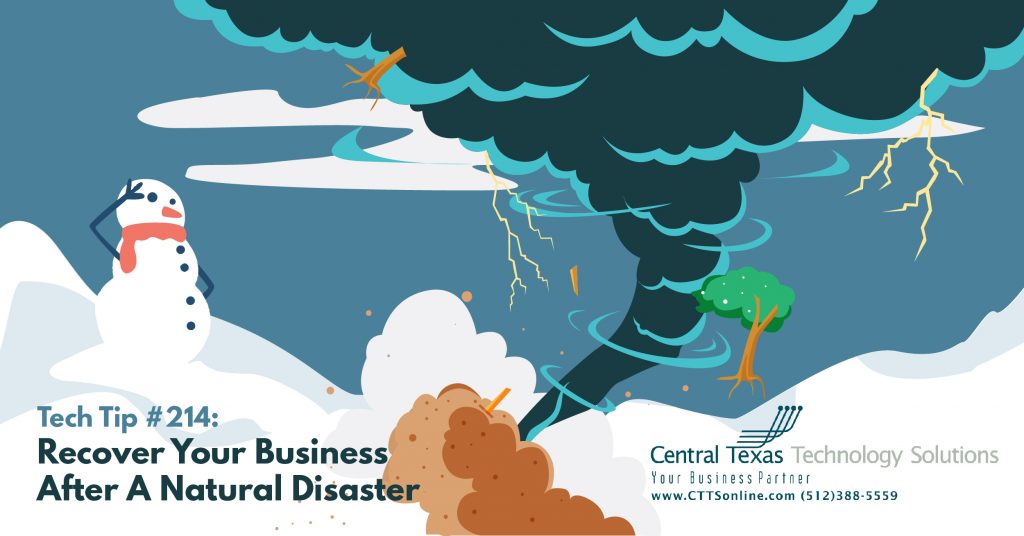 As we have all recently witnessed here in Texas, a natural disaster can threaten not only your personal safety and the safety of your property, but the livelihood of your business as well. Once you and your employees are ready and able to safely return to work, follow the guidelines below to ensure a smooth transition back to normalcy.
As we have all recently witnessed here in Texas, a natural disaster can threaten not only your personal safety and the safety of your property, but the livelihood of your business as well. Once you and your employees are ready and able to safely return to work, follow the guidelines below to ensure a smooth transition back to normalcy.
Here Are 5 Ways To Recover Your Business After A Natural Disaster:
- Evaluate - First, take a step back evaluate the situation. It can be easy to feel overwhelmed, so start by answering these three questions:
- Is it safe for your employees to come back to work? - Once the roadways leading to and from the location of your business are safe to travel, survey the area and check to make sure there is no external or internal damage to your business property. Document all losses or damage and contact your insurance company ASAP. Be prepared to take damage control steps as well.
- Can everyone access power, water, and Internet? - You'll want to ensure that there is steady power and Internet connections. You may need an alternate location for your employees to work if there is no power, water, or Internet. Make sure that all your employees have stable conditions at home as well. Many employees will have to deal with their own family and property issues, so consider split shifts or even time off. A little extra understanding goes a long way, if your employees feel undervalued or overworked during a natural disaster, some may consider resigning. This could leave you severely understaffed.
- What critical business activities need to continue? - If your employees or customers do not have access to essential applications and data, there will be a direct impact on productivity and revenue. Create an inventory list of what it takes to run your company. This could include software and hardware like Switches, Router, Modems, and Servers to name a few. You may also need to temporarily find alternate suppliers or vendors to help you access other materials necessary to run your business.
- Communicate - Keeping your employees informed will be absolutely critical to everyone’s health and safety. This is especially vital in the case of a natural disaster causing damage and destruction to a business. You'll need a written communications strategy that includes important facts, information and advice ready to send out to staff, suppliers, clients and customers and, if need be, the media, to ensure those who should be informed are kept up to date.
- Resuscitate - Does your company have a Disaster Recovery and Business Continuity plan? The advanced documentation of what happens during a downtime situation will ensure your business can have the capability to operate its critical business functions during emergency events. Events can include natural disasters, a business crisis, pandemic, workplace violence, or any event that results in a disruption of your business operation. It is important to know how much downtime you can afford to lose. Most businesses cannot afford to lose any time, so they must always be up and running and they'll need an existing recovery plan in place to quickly make that happen. Data recovery is not something you can set and forget either, you'll need to regularly test your backups, at least on a yearly basis. Every time you get new equipment, first test, then add it in your recovery plan as well.
- Replicate - Do you have a backup location for your servers? If you're relying on all your data surviving in just one location, you're at risk to losing it all if your main location fails. Most of the time, companies will have their servers housed miles away. If you really want to do it right, look at having your server and backups hosted in a different state all together.
- Another option is hosting your data in the Cloud. Depending on the type of business that you own and the type of software needed to keep things up and running, going to the Cloud may even be cheaper than your physical server. Most companies will often benefit from working out of the Cloud because of the ability to work from anywhere. If you have the right tools and equipment, you can even be on vacation while working (though I wouldn't recommend it) and if there is a disaster and you are unable to physically go into the building where you work, with the Cloud, you have the availability to be working almost 99.999 of the time. Why not 100 percent of the time? There is always the potential to lose your internet connection, but hopefully that is only .001 percent of the time.
- Replicating your backups to at least one remote server or cloud is the insurance that protects you should you lose your data due to a successful ransomware or malware attack, or other data disaster. Hybrid solutions take your protection to an even higher level by replicating your backups to both a remote server and the cloud.
- Appreciate - While a business needs to be operating as quickly as possible following a natural disaster, it is important to remember that workers, managers, and bosses are only human and will need time to recuperate from the disruption and stress. Ensure employees are mentally and physically prepared to return to work following a disaster as going back to work too early is likely to result in an unproductive workforce and low morale. Having cloud-based systems and remote-working technology set up can mean the business could operate even if the premises are not ready or the staff does not feel emotionally ready to return to the facility where the disaster struck.
So, if you are looking at taking business to the Cloud or would like some help in creating a plan for your business disaster recovery efforts, schedule a free IT consultation today, or give myself and the technology experts at CTTS a call now: (512) 388-5559.

By Ramon Kreher
Desktop Support Technician
Central Texas Technology Solutions
